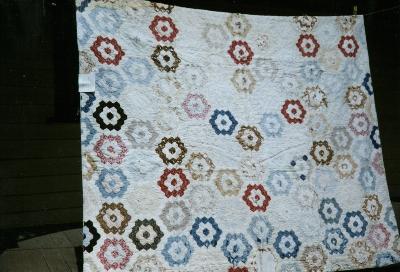Quilt No.171KHS - Kaniva District Historical Society

2236 x 1829mm
Made by Mary Ann Clark (1828-1917), later Mrs John William Wake King, about 1845, in England. In 1915 it was given to her grand-daughter Emily King (Mrs Champness), second daughter of Mary Ann's eldest son William Frederick. In 1977 the quilt was donated to the Kaniva District Historical Society by the family of Emily's eldest daughter Irene (Mrs H.L. Williams).
Mary Ann Clark came from Spalding, Lincolnshire. On 31 March, 1850, she married John William Wake King, of London, at Trinity Church, Regent Park, London. John was a boot and shoe maker. Mary Ann King took out a prize for book binding at the Paris Exhibition in 1851.
John decided to emigrate to Australia for health reasons and he, Mary Ann and their two children arrived at Port Adelaide on 16 November, 1853, on board the 'Olivia'. John took up work as a shoe maker with a Mr H.M. Jackson of Nairne, and later took over the business. From 1855 to 1857 John was at the Victorian gold giggings, but did not do very well. In 1857 he returned to Port Adelaide, walking back to Nairne, and took up business as an agent and auctioneer.
Related Quilts:
2300 x 1880mm
1700 x 1200mm
2590 x 2170mm
760 x 660mm
2400 x 1700mm
2591 x 2540mm






